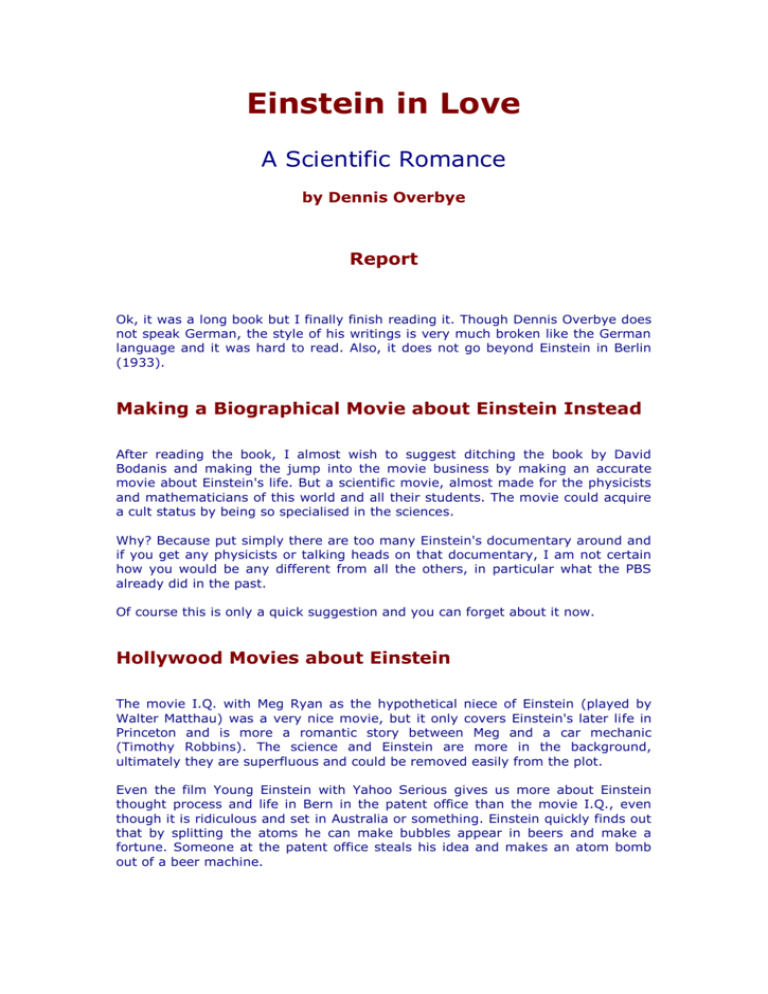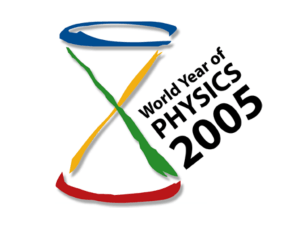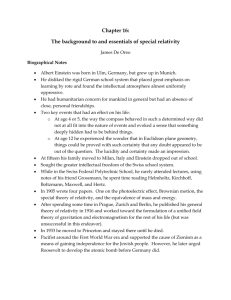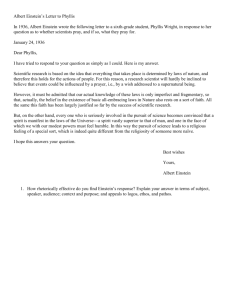Einstein in Love, A Scientific Romance
advertisement

Einstein in Love A Scientific Romance by Dennis Overbye Report Ok, it was a long book but I finally finish reading it. Though Dennis Overbye does not speak German, the style of his writings is very much broken like the German language and it was hard to read. Also, it does not go beyond Einstein in Berlin (1933). Making a Biographical Movie about Einstein Instead After reading the book, I almost wish to suggest ditching the book by David Bodanis and making the jump into the movie business by making an accurate movie about Einstein's life. But a scientific movie, almost made for the physicists and mathematicians of this world and all their students. The movie could acquire a cult status by being so specialised in the sciences. Why? Because put simply there are too many Einstein's documentary around and if you get any physicists or talking heads on that documentary, I am not certain how you would be any different from all the others, in particular what the PBS already did in the past. Of course this is only a quick suggestion and you can forget about it now. Hollywood Movies about Einstein The movie I.Q. with Meg Ryan as the hypothetical niece of Einstein (played by Walter Matthau) was a very nice movie, but it only covers Einstein's later life in Princeton and is more a romantic story between Meg and a car mechanic (Timothy Robbins). The science and Einstein are more in the background, ultimately they are superfluous and could be removed easily from the plot. Even the film Young Einstein with Yahoo Serious gives us more about Einstein thought process and life in Bern in the patent office than the movie I.Q., even though it is ridiculous and set in Australia or something. Einstein quickly finds out that by splitting the atoms he can make bubbles appear in beers and make a fortune. Someone at the patent office steals his idea and makes an atom bomb out of a beer machine. A movie showing Einstein's struggles with his theories and how he came to them would be much more interesting, with his family problems in the background and all the physicists he meets and the world he was living in in those days. General Comments about the Documentary For this report I am explaining some of Einstein's key life events (even though this is not what we are doing) from which bits could end up in the documentary. Then again, you thought that having an Einstein impersonator was not a great idea in one of the documentaries we had, but if you wish to do reconstructions then I think we should have an Einstein actor and at least his wife Mileva and his sons, as well as his second wife Elsa. We might need his best physicists friends like Lorentz, Michele Besso (maths), Grossman, Planck, Abraham and his good friend in Zurich Mr. Zangger. Zangger had a lot of influence in getting Einstein into gear and working in Zurich as a teacher, even though he was not a physicist. I fear that if we only want to show some bits of Einstein's life, we might fall into the trap of the clichés. Even though instead of showing him in the patent office we would show him as a teacher in Prague, Zurich or Berlin where he had no courses to give as the director and was the only employee of the new Physics Institute they created for him. For the documentary it would be more important to show how Einstein got to develop his ideas than showing what these ideas are, trying to explain special relativity with nice little physicists in space ships, one on Earth and one at high speed in space. That we want to avoid, unless we show exactly what Einstein used to help visualise his theories (like all the clocks in the distance showing different timings in the chapter called Six Weeks in May (pp.124-140)). Again nothing new there, it has been done before with similar kind of examples. The Influence of Faraday and Lavoisier on Einstein By the time Einstein went to develop his theory of Special Relativity, he never even gave another thought about Michael Faraday and Energy, or AntoineLaurent Lavoisier and his mass. Later he does not even appear to think about Cassini, Meitner or others. By the time the race to the Nuclear Weapons is started, he his already far into his own ideas. Then again, in the documentary we have already established that we will not talk about Einstein that much and we will instead cover these other areas that have nothing to do with Einstein. Mass and Energy were already so established in 1900 that Einstein was taking them for granted. He just made the link that mass was, from the point of view of Physics, like energy. And if you can picture an atom - and at the time they did not even know if it existed, if it was a particle or a wave - then it was just a ball of electricity, so it was a ball of energy anyway, though it had a mass. E=mc2 Einstein stated that the laws of physics were the same for anyone anywhere going at any speed. E=mc2 and mc2=E are both true. You can reverse the equation and it still works, which makes it possible to create huge amount of Energy and make a bomb. The difference is that Einstein realised that there was equivalence between mass and energy and it was link to the speed of light because of his vision of Special Relativity where the speed of light is constant for everyone. In fact, E=mc2 is not something that came to mind when he wrote Special Relativity and when he send it to the Annalen der Physik, the main newsletter of the time in Germany that every physicists were reading. E=mc2 was an afterthought, a consequence of it, and he quickly wrote three more pages that he sent to the editor in time for publication. How Einstein came to think about Special Relativity When doing his Special Theory of Relativity Einstein was more interested in riding on a wave at the speed of light to see what would happen. He was also deep into James Clerk Maxwell and his light and electromagnetism waves set of equations. Even Thermodynamics played an important role, like if all of what Einstein's worked on, and he worked on everything Physics had to offer at the time, was somehow link to his main Relativity Theories. It is not hard to understand why, Relativity has rewritten the history of Physics, changed its landscape forever. In two words, it was the death of Newton, the person that was central to everything Einstein did and central to everything going on in Physics. He basically told the world that Newton was wrong completely, apart from his Calculus that would come very handy in Special Relativity. I think everyone knows about the little experiment about the light speed being constant and that the laws of Physics stand true for anyone at any speed anywhere in the universe and that we live in a very relativistic universe. Everyone knows about the example of a light beam hitting a panel and some clocks registering the time it takes and the path it follows differently depending on your position and speed. What is less known is how Einstein got to these discoveries. Like for example realising from Thermodynamics* that the vision of the world had to be relativistic to the point of view or frame of reference. The radiation and absorption of light by blackbodies (Planck's work) is something Einstein thought a lot about and he got many things out of it, more specifically that light could be particles* and a statistical way of looking at the motion of molecules and atoms (the whole starting point of the Quantum Theory). At that time, quanta (particles of matter or atoms) and the photons (light being composed of particles called photons) was not even accepted by most of the scientists. *Thermodynamics: physics of energy and mechanical actions: the branch of physics that deals with the conversions from one to another of various forms of energy and how these affect temperature, pressure, volume, mechanical action, and work. *Photoelectric Effect (Einstein Nobel Prize): The photoelectric effect is a process in which an atom absorbs a photon that has so much energy that the photon sets one of the atom’s electrons free to move outside the atom. Part of the photon’s energy goes toward releasing the electron from the atom. This energy is called the activation energy of the electron. The rest of the photon’s energy is transferred to the released electron in the form of motion, or kinetic energy. Since the photon energy is proportional to frequency, the released electron, or photoelectron, moves faster when it has absorbed high-frequency light. We need to go further in explaining how Einstein reached his conclusions and how it was received by the scientific community. We might in the end have to give up and show these examples visualising Einstein's theories since there is perhaps no other ways to tell the audience what relativity is exactly. The thing is, you explain these little examples like a guy in an elevator in space and one on Earth, to show that acceleration and gravity are the same thing, and people still don't understand. 10 more questions arise because often it does not correspond to the logic of our day to day life. We will have to make sure we explain these experiments well by putting those examples in their context and where they came from and where they lead to. Einstein's Life Einstein was born in Ulm in Germany in 1879 and moved to Munich with his family a year later. He soon rejected his German nationality in order to avoid military service after the family moved to Pavia just outside Milan in 1890. There his father and his father's brother were working at building electromagnetic machines in order to produce electricity for different cities. The family business never really made any money and had to declare bankruptcy at one point. Einstein's father died owing money to some other uncles that financed the various projects. Einstein's family after the death of the father also lived in southern Germany and ended up in Berlin. It explains why Einstein decided to take the post in Berlin in April 1914 where he would have much less work to do and could just think for a living. Also his cousin Elsa was quite popular in the Berlin's milieux and was a door opener for Einstein. She is the one who got him his job in Berlin in order to reunite the lovers, as Einstein was then in love with her and could not really cope anymore with his wife Mileva's mood and depression. When the First World War raged on, Einstein was right in the middle of it and he was against it. He did try to draw more aerodynamics planes for the German Army but he did not know much about it and it was a disastrous result. It is important to mention that his boss was the guy responsible for most of the military machine in Germany and his director worked on Ammonia in order to make bombs and he also developed gas mustard. Another important colleague was responsible for the submarines. Albert played a major role during the First World War as an activist for peace. He attended some meetings that gave him a bad reputation and he did also hide some political dissidents in his home. After the war he was considered like a pacifist hero. In all, I find it quite ironic that Einstein was right in the middle of all this, and also played an important role in the Second World War. When it comes to it, physics is central to the technology of weapons and wars. I suppose it is then normal for great physicists to be involved even though their main motivation could have something to do with revealing the nature's underlying laws. Ultimately it is the applications of those laws and equations that interest governments and war machines. Mileva (a student in Physics that Einstein met in 1900 when studying in Zurich) already did not like too much moving to Prague in April 1911 where Einstein was teaching and was very happy when Einstein was offered a position as a busy teacher in Zurich in August 1912. Later, the move to Berlin was too much because the mother of Einstein never liked her as she was not Jewish and was, from the mother's point of view, a sick child from Serbia (then part of the Austrian-Hungarian Empire). Mileva was not good enough for Einstein. She poisoned her two sons mind against Einstein and even managed to turn against Einstein his best friends Besso and Heinrich Zangger (a professor of forensic medicine at the University of Zurich). They thought it was not acceptable the way Einstein handled his kids and abandoned his wife for Elsa. It is interesting to note that the Einsteins had an illegitimate girl before getting married, she has been lost in all the documents we have today and no one knows if she died of a sickness or was given away for adoption. While in Prague Einstein was now considered one of the greatest physicists and he was going and speaking at conferences all around Europe, especially the special and exclusive Solvay Congress that started in 1911 and who brought together that first year Einstein, Marie Curie, Ernest Rutherford, James Jeans, Henri Poincaré, Lorentz and Planck. They were discussing the electrons, the atoms, quantum mechanics, radioactivity, relativity and Einstein's discoveries. All his life Einstein regularly met with other fellow physicists with whom he continued writing papers about relativity and publishing in physics' newsletters. He played violin very well and played all the time at home and when going to meet friends. He also played violin at the conferences he spoke at in Europe and it was often considered the highlight of the event. Before meeting Mileva in Zurich, Einstein studied in Aarau in Switzerland and was living with the Winteler family. He fell in love with Marie, one of the young daughters, but he rejected her once in Zurich. She ended up in a mental institution as a consequence, but later on married in Bern and had two children. Later on, one of the derange brothers of the Winteler family killed his mom and brother-in-law before committing suicide which did not help Einstein's guilt toward Marie. Einstein's family thought Marie was a great choice for Einstein. One of Einstein's sister had married with one of the Winteler family, even Grossman, Einstein's close friend, married one of the Winteler's daughters. On 14 February 1919 when Einstein finally got his divorce from Mileva (at high costs) he was now free to marry his cousin Elsa. The problem then was that perhaps he should marry her daughter Ilse instead (Elsa had two daughters, the other one was called Margot). Even Elsa was ready to step out to let Ilse marry Einstein that grew attracted sexually to her, but ultimately she decided against it and Einstein married Elsa on June 2 1919. Einstein was awarded in 1922 the Nobel Prize for Physics of 1921 for his theories about light and the Photoelectric effect. Einstein stayed in Berlin until 1933 when Hitler came to power. He took this as his time to leave Germany and moved with Elsa (who died in 1936) to New Jersey where he was offered a nice job at Princeton where he could continue to think as a living. Around 1920 and for most of his relationship with Elsa, he has been sleeping with many women on the side and had many affairs, already in Zurich whilst with Mileva he has been known to go to brothels. After Elsa's death he continued to have affairs in Princeton. He did not lay his last egg which was the Theory of Everything or Unified Field Theory that would unite the world of Relativity with the world of Quantum Mechanics (or electromagnetism) that he had started around 1905 and continued in 1916 after he discovered General Relativity. He did work on all the new revolutions that Niels Bohr, Werner Heisenberg, Erwin Schrödinger and Wolfgang Pauli were discovering about the atom though he never really liked the directions in which they were going. He died in April 1955 as a living legend from an aneurysm in his abdominal aorta that bursts, the source of his lifelong stomach problems. His brain ended up in Ontario Canada for some reasons and they found out that his parietal lobe, a region associated with mathematics and spatial relationships, was 15 percent bigger than a normal person's. I am not certain if he was born with this or if it developed in time because of all his thinking about space and time. At the end of the book of Overbye, there is an epilogue telling us what happened to everyone that is discussed in the book. Key Points of the Book I particularly liked in the book how Overbye describes in details Einstein's thought process leading to special relativity and later on to general relativity. You really feel that suddenly an idea comes his way and from that he goes to devise a set of equations that does not work and finally another idea comes in and he gets it. When Einstein realises that gravity is geometry and that he is lost inside Ricci and Metric tensors trying to figure out if he can predict the orbit of Mercury which had puzzled every astronomer since the early years of that discipline, and when it works, you feel you are there with Einstein to enjoy his genius. You can see just how destiny appeared to have laid out in his paths the right people at the right time in order for him to make the leap and realise that the universe does not really obey normal Euclidian geometry, but instead the weird and twisted geometry of Gauss and Riemann that needs complicated tensor algebra to be calculated. Just extraordinary that the mathematician who was helping him all these years had an interest in this special geometry, Besso made his Ph.D. on it. It is quite surprising how Einstein suddenly realised that gravity is geometry and that planets are following this distorted sheet of rubber in space. Of course, this is General Relativity, but it does not go without Special Relativity, it is completing the theory perfectly and answers what Special Relativity could not about gravity. Notable Chapters Notable chapter in Overbye's book that I will give you back on Friday are Six Weeks in May (pp.124-140) where Einstein discovers Special Relativity. Then King of the Hill (pp.132-247) and The November Revolution (pp.283-298) where Einstein struggles with Riemann's geometry and understands General Relativity. Special Relativity in my own words Special Relativity derived from the facts that the speed of light is always constant for anyone anywhere going at any speed. As a result clocks (time) do not run at the same rate everywhere, it depends on your acceleration and the gravitational forces (that last point was uncovered in General Relativity which is a theory of gravity). Both acceleration and gravitation changes the values of time, length and mass, which are all relative to the point of view or frame of reference. There is no absolute motion, absolute space or absolute time in the universe. There is no universal clock somewhere on which we can time our clocks or a centre to the universe. Anywhere can become a frame of reference and the laws of physics would stand true in any frame of reference. Someone else in another frame of reference would calculate a different reality than yours. For example light might appear to cover a longer distance in the same amount of time from your point of view compared with someone else moving with that lamp on his ship. The speed of light is fast but not that fast, it is not instantaneous, and it takes time to reach people. The image of a star exploding would not arrive to two persons living on different planets at the same time, it could happen years before on planet 1 compared with planet 2. One event is therefore not simultaneous to different observers. Special relativity also proved that Energy and Mass are the same and are interchangeable. General Relativity in my own words General Relativity is to place that Energy and Mass in Space and Time, and it gives you the geometry of space (gravity). Instantly with about 10 points (tensor algebra) you can calculate anything anywhere in four dimensions instead of three, and you get a much better view of the universe, of the unity of the distribution of energy and mass in the geometry of space and time. General Relativity added a fourth dimension, the dimension of time. Even a rocket at rest is moving in time. General Relativity also brought along the fact that the universe is curved, a straight line is not necessarily the shortest distance between two points (the geodesic). The geometry of space (that is the result of the mass and the energy populating it) is curved in the neighbourhood of massive objects and light would bend following these curved lines. The whole universe could be a hypersphere in which, if you light a super flashlight, light would eventually get back to you from behind. It is like going around the Earth and eventually coming back to where you are as it is a sphere in three dimensions. In four dimensions, the universe looks more like a balloon being blown or a hypersphere. It could also be a hyperbolic or another form, we just don't know at this time. Even though photons are mass less because they are going at the speed of light, light is energy (which is equivalent to mass) and has momentum, which is known to apply pressure on whatever it meets. Superstrings in my own words (and it is much more complicated than that) Superstrings at the moment are pushing those boundaries by trying to calculate everything in higher dimensions, up to 10 instead of four. They hope to be able to see much further this way and completely unite Relativity with Quantum Mechanics, and also find a theory of gravity for the quantum world (the infinitely small). After all, it worked for Einstein when he added the fourth dimension of time to his equations. Adding more dimensions apparently brings equations that explain much more about the mechanics of the universe. Conclusion Please don't be afraid to ask for more, whether about Einstein's life or any topics discussed in this report. It would be my pleasure to go in the details. Roland Michel Tremblay 44E The Grove, Isleworth, Middlesex, TW7 4JF Tel: 020 8847 5586 Mobile: 0794 127 1010 rm@crownedanarchist.com www.crownedanarchist.com






